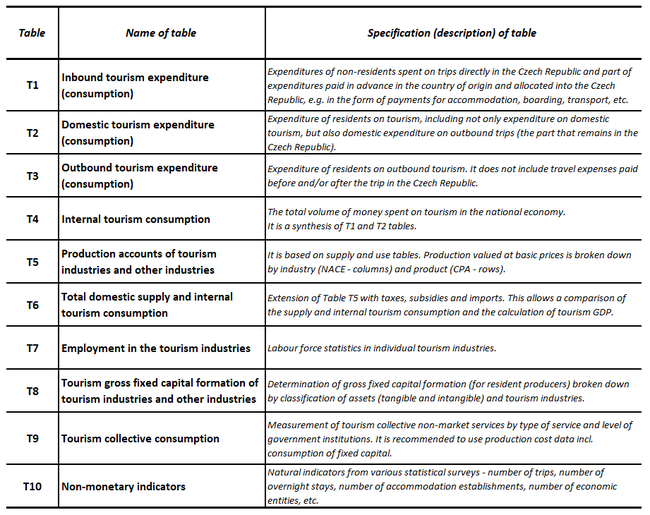Tourism Satellite Account (TSA) - Methodology
Basic methodological framework
The Tourism Satellite Account (TSA) provides information and data on the economic position of the tourism industry. It is the only objective tool for international comparison of the economic importance of tourism.
The basic methodological framework of this mathematical-statistical model is the result of the joint efforts of the United Nations Statistics Division (UNSD), the United Nations World Tourism Organization (UNWTO), Organization for Economic Co-operation and Development (OECD) and the Statistical Office of the European Union - Eurostat.
Key documents of the Tourism Satellite Account:
International Recommendations for Tourism Statistics, 2008 (IRTS 2008)
Tourism Satellite Account: Recommended Methodological Framework, 2008 (TSA: RMF 2008)
European Implementation Manual on Tourism Satellite Accounts
Tourism Satellite Accounts in the European Union, 2010 (Volume 1 – Volume 4)
Tourism Satellite Accounts in Europe – 2010, 2013, 2016, 2019, 2023 Edition
Tourism Satellite Accounts on Europe - Experimental statistics
System of National Accounts, 2008 (SNA 2008)
The European System of Accounts, 2010 (ESA 2010)
The Tourism Satellite Account, in addition to the most requested information on the share of tourism in gross domestic product, contains a comprehensive set of mainly economic indicators about tourism as an economic sector. It makes it possible to monitor the development of the sector in the national economy and its importance in relation to other economic sectors and also the position or performance of the sector in international comparison. A considerable amount of detailed information and data is used in TSA compilation process. Nevertheless, more or less aggregated data is published due to the appropriate statistical reliability.
TSA concept and goals
The TSA is a modern and still relatively new methodological tool for research and understanding of tourism. The basic cornerstone of this tool is a comprehensive approach to understanding the context and links of individual indicators describing the demand and supply of tourism.
The complete (so-called full-fledged) TSA should provide:
- Macroeconomic aggregates, which describe the size and economic importance of tourism, e.g. tourism gross value added and tourism gross domestic product, and which correspond to similar aggregates in the economy as a whole;
- Details about visitors' consumption and how domestic supply and imports correspond to this consumption (this data is integrated into tables and matrices derived from the general supply and use tables used in the national accounts);
- Detailed production accounts of individual tourism industries, including data on employment and connection with other productive economic activities and capital formation;
- Basic information required for the development of models of the economic impact of tourism;
- Link between economic data and other non-monetary information on tourism, e.g. number of trips, duration of stay, purpose of trip, modes of transport, etc.
TSA structure - System of tables
The basic structure of the TSA is based on the general balance existing in the national economy, i.e. the balance between demand and supply of the product created by the tourism industry. In the context of macroeconomic analysis, it is best to examine the relationship between supply and demand according to the general framework of national accounts and more specifically according to the supply and use tables. Therefore, the Tourism Satellite Account uses the same basic concepts, definitions, classifications and compilation principles as the national accounting system.
The TSA system consists of 10 tables, the form of which is determined by international methodological manuals.
Overview of the basic TSA system

Structure of outputs
In the Czech Republic, the outputs of the Tourism Satellite Account are divided into three key and interconnected areas of statistical products:
Tourism Satellite Account Tables
- Economic indicators of tourism impact in terms of supply and demand
- Importance of the tourism industries for the economy of the Czech Republic in terms of employment
Regional Tourism Satellite Account
- Economic indicators of the importance of tourism in the regions (NUTS 2 / NUTS 3)
Characteristics of published data
The Tourism Satellite Account only measures the direct impact of tourism assuming a direct relationship between the provider of the product or service and the consumer (the visitor in this case). The effects of indirect influence have not been quantified yet, as well as a broader concept of leisure activities (these activities are not monitored in the Czech Republic).
For reasons of methodological comparability, the results are published from the reference year 2003 (regional data from 2010).
Most data is published (also due to its nature) at the national level.
Nevertheless, Regional Tourism Satellite Account provides basic information (tourism gross value added, number of people employed) about economic importance of tourism also in regions of the Czech Republic. It represents a regional specification (breakdown) of the Tourism Satellite Account (TSA) on the national level. A "top-down" method is used for the compilation. Data is broken down by the NUTS classification (a common classification of territorial units for statistics of the European Union) to the NUTS 2 level - cohesion regions and NUTS 3 - regions.
